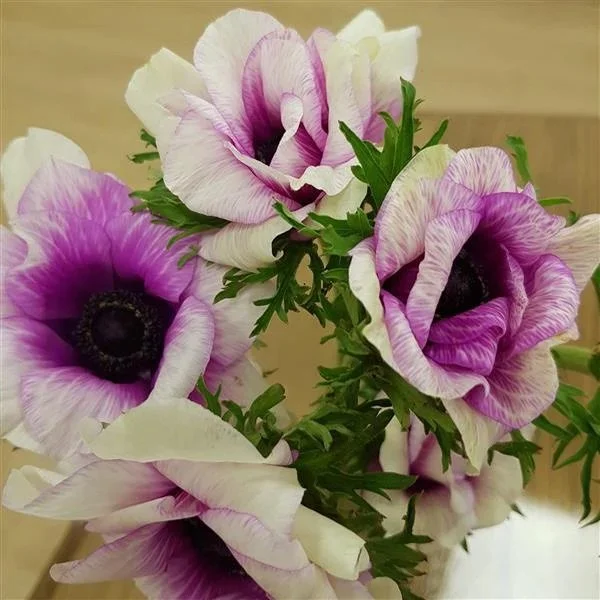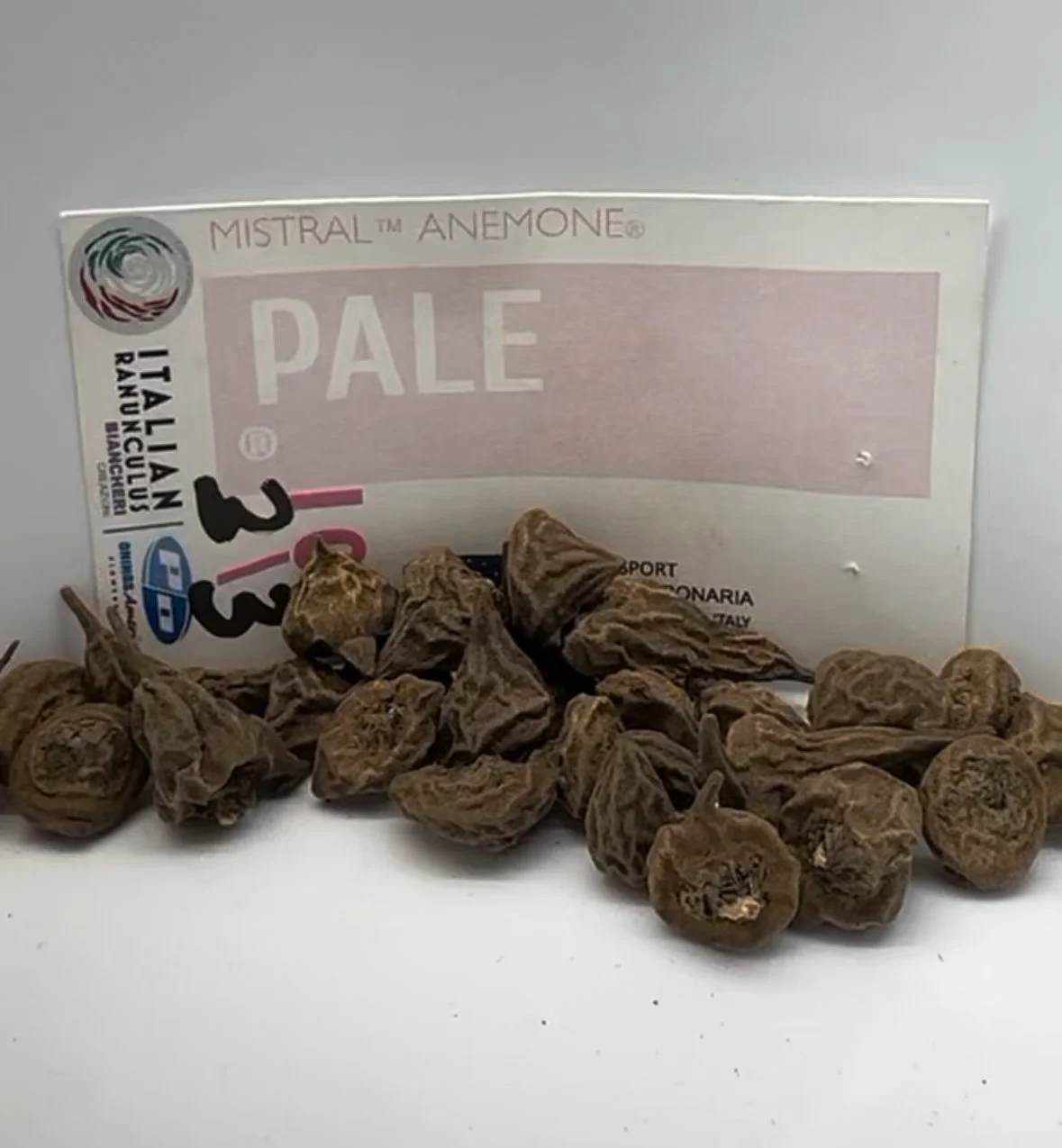 Image 1 of 2
Image 1 of 2

 Image 2 of 2
Image 2 of 2



Anemone Rainbow Violet Pastel
Pack size : 10 corms
Fall Shipping (late September - late October)
Anemone ‘Rainbow Violet Pastel’
A soft splash of spring color
Anemone ‘Rainbow Violet Pastel’ brings a gentle beauty to the spring garden with its soft, open flowers in shades of lilac, mauve, and blush. Light on their stems and delicate in form, they seem to hover above the foliage—simple, graceful, and full of quiet charm.
Perfect for front-of-border planting, containers, or naturalizing through grass or under trees, these anemones reach around 10–12 inches tall and spread to about 6 inches wide. Small in size, but striking in effect—especially when planted in generous drifts.
How to Plant & Grow
Quick Planting Guide
Planting time: Fall in mild climates (Zones 7–10), or early spring after frost in colder climates
Soil: Loose, fertile, well-draining
Depth & spacing: 2–3" deep, 6" apart
Light: Full sun (with some afternoon shade in hot regions)
Bloom: 12–14 weeks after planting (fall planting = late winter–spring blooms; spring planting = late spring–early summer blooms)
Step-by-Step Planting Instructions
1. Prepare the corms
Anemones come as dry, hard corms.
Soak in cool to lukewarm water for 4–6 hours before planting. This hydrates them and speeds sprouting.
You may notice little “claws” or bumps on the corm — that side goes down when planting. If unsure, lay them sideways.
2. Pre-sprouting (optional, but highly recommended for cut flowers)
For stronger plants and earlier blooms, you can pre-sprout your corms before planting outdoors:
After soaking, place corms in a shallow tray with slightly damp vermiculite, peat, or potting mix.
Store in a cool, dark spot (around 40–50°F / 4–10°C) for 1–2 weeks.
Once little white root nubs appear, they’re ready to be planted into beds or pots.
3. Prepare the planting site
Choose a location with full sun and excellent drainage.
Loosen soil at least 6–8" deep. Add compost for fertility and grit/sand if soil is heavy.
Raised beds or deep containers work very well if garden soil is not ideal.
4. Plant the corms
Plant 2–3 inches deep and about 6 inches apart.
Water well after planting to settle the soil.
If planting in fall in cooler climates, cover beds with frost cloth for extra protection.
5. Growing on & care
Watering: Keep soil evenly moist during active growth. Avoid overwatering.
Feeding: Once shoots appear, feed every 2–3 weeks with a balanced liquid fertilizer or organic feed for continuous flowering.
Mulching: A light mulch helps retain soil moisture and protect plants from temperature swings.
6. Bloom time & harvest
Expect blooms 3–4 months after planting.
Harvest stems when blooms are just beginning to open (the “wiggle stage” — when the flower head starts to move freely on its stem). This gives the best vase life.
Regular harvesting or deadheading encourages more blooms.
7. After flowering
Once flowering is finished and foliage yellows, you can:
In mild climates: Leave corms in the ground to rest over summer.
In cold or wet climates: Lift the corms, brush off soil, let dry in a cool, airy spot, then store in paper bags or mesh sacks until replanting.
Tips for Success
For a longer bloom window, stagger plantings every 2–3 weeks.
Protect young growth from slugs, snails, and frost.
Excellent as cut flowers — vase life is typically 7–10 days.
Looks stunning when paired with ranunculus, tulips, and other spring bulbs.
Pack size : 10 corms
Fall Shipping (late September - late October)
Anemone ‘Rainbow Violet Pastel’
A soft splash of spring color
Anemone ‘Rainbow Violet Pastel’ brings a gentle beauty to the spring garden with its soft, open flowers in shades of lilac, mauve, and blush. Light on their stems and delicate in form, they seem to hover above the foliage—simple, graceful, and full of quiet charm.
Perfect for front-of-border planting, containers, or naturalizing through grass or under trees, these anemones reach around 10–12 inches tall and spread to about 6 inches wide. Small in size, but striking in effect—especially when planted in generous drifts.
How to Plant & Grow
Quick Planting Guide
Planting time: Fall in mild climates (Zones 7–10), or early spring after frost in colder climates
Soil: Loose, fertile, well-draining
Depth & spacing: 2–3" deep, 6" apart
Light: Full sun (with some afternoon shade in hot regions)
Bloom: 12–14 weeks after planting (fall planting = late winter–spring blooms; spring planting = late spring–early summer blooms)
Step-by-Step Planting Instructions
1. Prepare the corms
Anemones come as dry, hard corms.
Soak in cool to lukewarm water for 4–6 hours before planting. This hydrates them and speeds sprouting.
You may notice little “claws” or bumps on the corm — that side goes down when planting. If unsure, lay them sideways.
2. Pre-sprouting (optional, but highly recommended for cut flowers)
For stronger plants and earlier blooms, you can pre-sprout your corms before planting outdoors:
After soaking, place corms in a shallow tray with slightly damp vermiculite, peat, or potting mix.
Store in a cool, dark spot (around 40–50°F / 4–10°C) for 1–2 weeks.
Once little white root nubs appear, they’re ready to be planted into beds or pots.
3. Prepare the planting site
Choose a location with full sun and excellent drainage.
Loosen soil at least 6–8" deep. Add compost for fertility and grit/sand if soil is heavy.
Raised beds or deep containers work very well if garden soil is not ideal.
4. Plant the corms
Plant 2–3 inches deep and about 6 inches apart.
Water well after planting to settle the soil.
If planting in fall in cooler climates, cover beds with frost cloth for extra protection.
5. Growing on & care
Watering: Keep soil evenly moist during active growth. Avoid overwatering.
Feeding: Once shoots appear, feed every 2–3 weeks with a balanced liquid fertilizer or organic feed for continuous flowering.
Mulching: A light mulch helps retain soil moisture and protect plants from temperature swings.
6. Bloom time & harvest
Expect blooms 3–4 months after planting.
Harvest stems when blooms are just beginning to open (the “wiggle stage” — when the flower head starts to move freely on its stem). This gives the best vase life.
Regular harvesting or deadheading encourages more blooms.
7. After flowering
Once flowering is finished and foliage yellows, you can:
In mild climates: Leave corms in the ground to rest over summer.
In cold or wet climates: Lift the corms, brush off soil, let dry in a cool, airy spot, then store in paper bags or mesh sacks until replanting.
Tips for Success
For a longer bloom window, stagger plantings every 2–3 weeks.
Protect young growth from slugs, snails, and frost.
Excellent as cut flowers — vase life is typically 7–10 days.
Looks stunning when paired with ranunculus, tulips, and other spring bulbs.